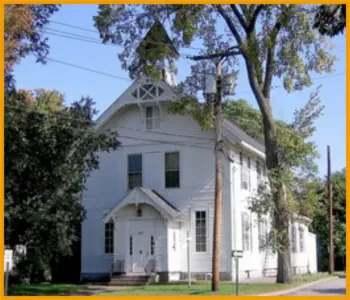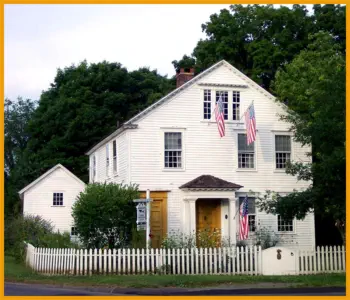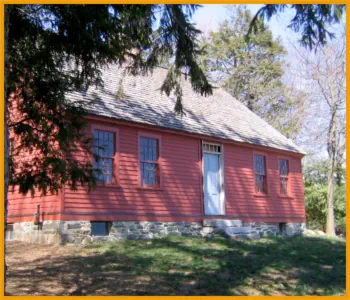



Orange Historical Society


Orange, Connecticut
History
History of Orange
The
Paugusset,
an
Algonquian
people,
once
lived
in
the
area
that
is
now
Orange.
In
1639,
the
Rev.
Peter
Prudden
purchased
the
land
from
the
Native
Americans
for
six
coats,
ten
blankets,
one
kettle,
twelve
hatchets,
twelve
hoes,
two
dozen
knives
and
a
dozen
small
mirrors.
When
originally
settled
by
English
colonists,
Orange
was
the
northern
and
eastern
district
of
the
now
neighboring
city
of
Milford;
however,
by
1822,
the
population
of
the
area
had
grown
to
the
point
where
residents
desired
to
form
their
own
separate
community, thus forming the town of Orange.
The
town
is
named
after
William
III
of
England,
who
was
Prince
of
Orange
from
birth.
William
is
remembered
for
succeeding
James
II,
deposed
in
the
Glorious
Revolution
of
1688.
James
II
had
been
considered
a
despot
in
Connecticut;
he
had
famously
and
unsuccessfully
commissioned Edmund Andros to seize Connecticut's Charter.
The
town
continued
to
grow
throughout
the
19th
century.
As
early
as
1848,
a
separation
of
Orange
and
West
Haven
was
considered.
It
was
not
until
1921
that
the
two
were
officially
separated
by
act
of
the
Connecticut
General
Assembly
and
the
new
city
of
West
Haven
was
formed
out
of
the
southeastern
portion
of
Orange.
This
gave
the
remnant
town
of
Orange
a
very
rural
feel,
as
the
bulk
of
the
urbanized population was ceded to West Haven. In the post-war years, however, Orange began suburbanizing at a rapid pace.
Early
roads
through
the
area
included
the
Boston
Post
Road
(now
U.S.
Route
1)
and
the
Derby
Turnpike
(now
Connecticut
Route
34).
The
turnpike
was
originally
an
Indian
path.
A
toll
road
through
Orange,
from
New
Haven
to
Derby,
was
built
starting
in
1800.
The
toll
house
was
located
in
Orange;
tolls
ended
in
1887.
The
New
Haven
and
Derby
Railroad
ran
through
Orange
starting
in
1871,
with
a
station
in
Orange.
At
its
peak,
there
were
eleven
trains
per
day
in
each
direction
along
with
one
freight
train.
The
advent
of
a
trolley
from
New
Haven
to
Derby
(starting
in
1904
and
running
until
1937)
hastened
the
end
to
rail
service
(in
1925).
Later,
the
construction
of
the Wilbur Cross Parkway and Interstate 95 brought highways through the area.












Bryan Andrew








History of Orange
The
Paugusset,
an
Algonquian
people,
once
lived
in
the
area
that
is
now
Orange.
In
1639,
the
Rev.
Peter
Prudden
purchased
the
land
from
the
Native
Americans
for
six
coats,
ten
blankets,
one
kettle,
twelve
hatchets,
twelve
hoes,
two
dozen
knives
and
a
dozen
small
mirrors.
When
originally
settled
by
English
colonists,
Orange
was
the
northern
and
eastern
district
of
the
now
neighboring
city
of
Milford;
however,
by
1822,
the
population
of
the
area
had
grown
to
the
point
where
residents
desired
to
form
their
own
separate
community,
thus
forming
the
town
of
Orange.
The
town
is
named
after
William
III
of
England,
who
was
Prince
of
Orange
from
birth.
William
is
remembered
for
succeeding
James
II,
deposed
in
the
Glorious
Revolution
of
1688.
James
II
had
been
considered
a
despot
in
Connecticut;
he
had
famously
and
unsuccessfully
commissioned
Edmund
Andros
to
seize
Connecticut's
Charter.
The
town
continued
to
grow
throughout
the
19th
century.
As
early
as
1848,
a
separation
of
Orange
and
West
Haven
was
considered.
It
was
not
until
1921
that
the
two
were
officially
separated
by
act
of
the
Connecticut
General
Assembly
and
the
new
city
of
West
Haven
was
formed
out
of
the
southeastern
portion
of
Orange.
This
gave
the
remnant
town
of
Orange
a
very
rural
feel,
as
the
bulk
of
the
urbanized
population
was
ceded
to
West
Haven.
In
the
post-war
years,
however,
Orange
began
suburbanizing
at
a
rapid pace.
Early
roads
through
the
area
included
the
Boston
Post
Road
(now
U.S.
Route
1)
and
the
Derby
Turnpike
(now
Connecticut
Route
34).
The
turnpike
was
originally
an
Indian
path.
A
toll
road
through
Orange,
from
New
Haven
to
Derby,
was
built
starting
in
1800.
The
toll
house
was
located
in
Orange;
tolls
ended
in
1887.[5]
The
New
Haven
and
Derby
Railroad
ran
through
Orange
starting
in
1871,
with
a
station
in
Orange.
At
its
peak,
there
were
eleven
trains
per
day
in
each
direction
along
with
one
freight
train.
The
advent
of
a
trolley
from
New
Haven
to
Derby
(starting
in
1904
and
running
until
1937)
hastened
the
end
to
rail
service
(in
1925).
Later,
the
construction
of
the
Wilbur
Cross
Parkway
and
Interstate
95
brought
highways
through the area.
History

Orange Historical Society
Orange, Connecticut








Bryan Andrew










































































































































































